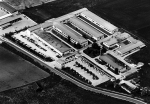Eumig production plants in Micheldorf & Kirchdorf
Kirchdorf location: Steiermärkerstrasse 49 / 4560 Kirchdorf a.d. Krems / Upper Austria
1945 The forerunner to the Kirchdorf production plant was a modest manufacturing workshop in nearby Micheldorf, where machines from the Vienna plant in the Buchengasse were taken at the end of the war for safekeeping. This was the location for the production of electric cooking hotplates, heating radiators, oil burners, and shoe irons after the end of the war, and also for the production of the first post-war radio equipment. The profits achieved from this were used to finance the rebuilding of the destroyed plant in the Buchengasse. After the Vienna plant had been reconstructed, radio manufacture was moved back there again.
1949 sees the production of the first components made of plastic (Bakelite).
1950 The "Eumigetta" camera is produced here, and the first diecasting machine for aluminium goes into operation.
1955 and plunger injection moulding machines for thermoplastics are already in operation.
1957 and a start is made on building work for a hall at Kirchdorf, two kilometres away.
1958 The casting department moves into Hall 1 in Kirchdorf
1959 As well as aluminium diecasting, a start is also made on magnesium diecasting
1963 Screw injection moulding machines go into action
1964 Hall 2 is completed and ready for the mould construction section, which was then brought over from Micheldorf.
1965 Completion of Hall 3, and the plastics manufacturing section moves from Micheldorf to Kirchdorf
1968 There are already six halls in operation. The old plant in Micheldorf is closed down. The working area amounts to 10,000m² including storage areas, social facilities, and the machinery building.
1975 The paintshop at the plant in Deutsch-Altenburg is closed down.
1976 The largest diecasting machine in Europe goes into operation (500 tonnes) In 1976 93 million plastic components are manufactured, and 9.7 million diecast parts.
1977 and there are 744 people employed: 297 women and 447 men. Diecast and plastic components are being manufactured, mechanical and surface machining, mould construction, quality control, a number of different support departments, the training workshop, and the magnesium resmelting plant are all located there.
1981 Eumig, the successor company, goes into liquidation

